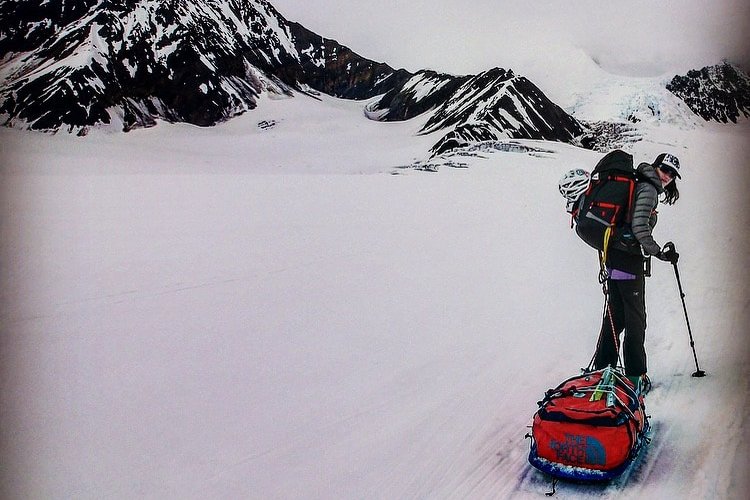Masha Gordon wasn’t an athlete when she was growing up. In fact, she failed gym class as an adolescent and couldn’t run a 5k just a decade ago. Instead, Masha dedicated the first part of her life to building a successful career as a businesswoman—even managing a 10-billion-dollar client portfolio at one time. But 7 years ago, Masha found the mountains and has since then developed a fervor for climbing the highest and most challenging peaks on Earth.
Masha, a mother of two, recently partnered with Sharpie Extreme to successfully complete and set a new world record for the Explorers Grand Slam—an endurance challenge that requires ascents of the world’s Seven Summits (each continent’s highest peak) as well as ski-trekking expeditions across both the North and South Poles. In achieving this arduous endeavor in under eight months, Masha not only established a new female record for the challenge but also set a second record as the fastest female to climb the Seven Summits; finishing all in just 238 days.
In this interview, Masha shares her journey to the realm of climbing, how she’s learned to overcome tremendous physical and mental obstacles, and a few key insights relevant to new and veteran climbers alike.
Could you speak about the influences growing up that may have contributed to your recent accomplishments?
I come from a completely different world than we’re in today. I grew up in Soviet times behind the Iron Curtain during the Cold War. I was not particularly athletic growing up, but nevertheless, I had this high image of mountaineers because the Soviet Union produced some of the world’s most amazing climbers. One of the great heroes of mine was Anatoli Boukreev; the climber many recall from Everest movies who refused to use oxygen on expeditions.
Boukreev was this extraordinary man who went on to tackle so many beautiful peaks and had this great saying,
Mountains are not stadiums where I satisfy my ambition to achieve, they are the cathedrals where I practice my religion.
So, I really came to relate to his view of mountaineering not only as a sport but as a very spiritual exercise. For someone who came from a world that was far removed from rock climbing or ice climbing—something that I didn’t really become acquainted with until I first went to Chamonix in my mid-30s—he captured my mind and appreciation for the mountains and a spiritual life at an early age.
On the topic of the mental and spiritual experience, what percent of achieving your recent objective was physical versus mental?
I would say 80% mental. Before I started, I would never have fathomed doing this. I couldn’t run 5k before I was 31.
While I came from a completely nonathletic background, I have learned to tap into a store of mental endurance that I accumulated in aspects of life external to the outdoors; such as through developing a successful business career and being a mother of two kids.
In the polar journeys of the Explorers Grand Slam especially, I was pushed outside of my comfort zone big time. Particularly in the South Pole … it’s such a mind-numbingly insane place. Imagine a flat white plane, and you’re skiing from one end to another, in a storm at minus 40 degrees Fahrenheit. So, how do you do this?
Especially as a woman, you can only do it by tapping into your mind, saying,
I’m gonna figure it out
and breaking the day into small objectives like, “Okay, I can ski one hour and not think about how hard it is—I’m gonna do fine.”
And trust me—it was hard; figuring out how to pull a sled in the arctic wind. I weigh 110 pounds and my sled had an extra 100 pounds of gear. It’s bloody hard to do and it was way out of my comfort zone; I’m a climber. Climbing rewards good strength to weight ratio, but in the case of hauling gear on skis like this, the heavier you are probably the better off you are. So, I had to figure out how to pull through, which made it a real test of mental endurance.
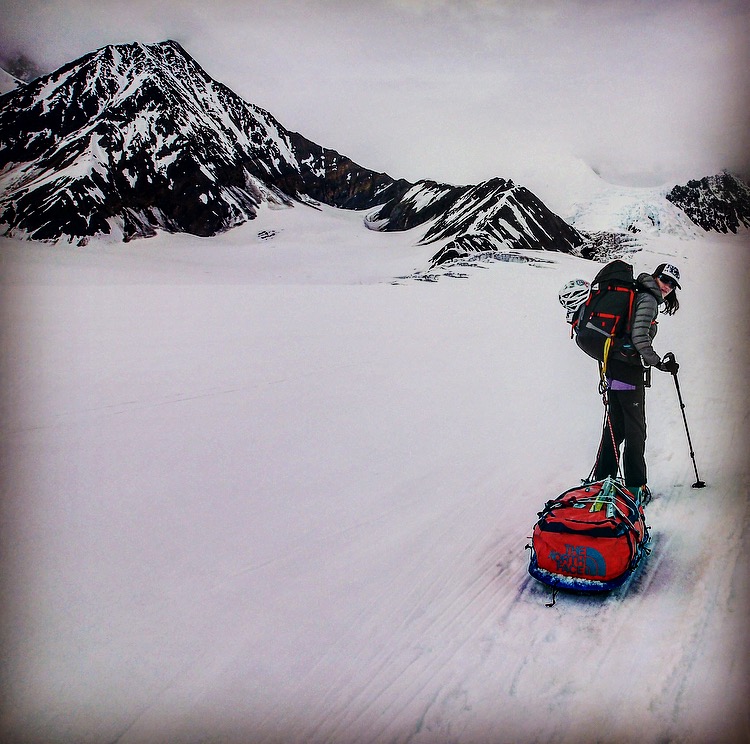
In high altitude mountaineering, sometimes the hurdles are not whether you can you climb 5.10, but the hurdle is can you get a good weather window, especially with Everest. You have a lot to figure out: you’ve used part of your oxygen and a store of your energy, and you’re preparing for the summit and then on the weather forecast, they tell you that you’re going to get 50mph wind. It’s about not freaking out; figuring out if you can jump in during the weather window, and whether you have enough ability and skill to get yourself off the mountain safely. So, a lot of it is about having the ability to handle and manage uncertainty.
The biggest thing in climbing is:
Can you push yourself beyond your fear? Can you rationalize what you fear and push yourself beyond that?
It’s not about being unsafe, it’s about realizing our true potential.
Some climbers use a trick when they’re getting pushed to the edge of their comfort zone and fear threshold—they’ll use a mantra or repeat some sort of phrase. Did you have something like this that helped guide you mentally?
When it came to the Cassin Ridge, getting to the summit of Denali, it was very committing—a scary environment and very cold. Basically, you traverse through the “Valley of Death”—which is aptly named because many climbers disappear there, never to be found, and you traverse through glacial terrain with seracs overhead and then get on an incredibly committing ridge.
Because of the lack of a reliable weather forecast, it’s very unpredictable. You really don’t want to be on that ridge with minus 30-degree Fahrenheit weather and non-summitable winds, because once you’ve made it through the Japanese Couloir (the largest single wall in North America with 39 pitches of ice and rock), you can’t turn back. For me, it was a big stretch.
But what kept me going was the little messages my kids wrote using Sharpie Extreme markers all over my gear and boots, like
Mommy, you can do it! I love you because you’re strong!
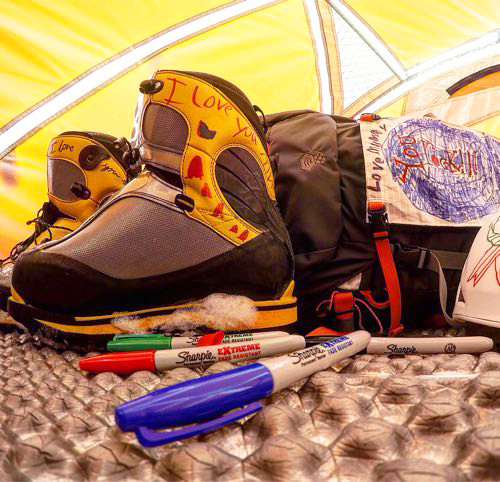
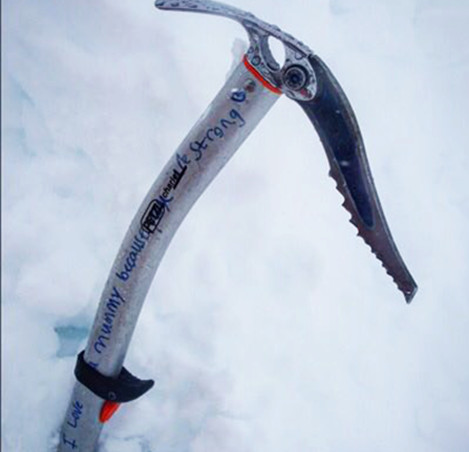
We planned on a 2-3 day journey, but the snow was really bad and ended up taking us 4 days, bivvying on tiny ledges. We were doing it alpine style, so we ran out of food, which meant the last day was really hard. We were up there at 20,000 feet and had two cliff bars and two gels between three of us on an eight-hour day just to the summit. Those messages from my kids definitely kept me going.
Seeing, “Mommy you can do it; come on!” that was really powerful. These kids had kept me going on this 7-month journey and I couldn’t let them down on my last objective.
With high altitude mountaineering, it’s really just about putting one foot in front of the other, staying present, and being there.
So, I couldn’t let them down—those messages reminded me of that.
How does having children affect your relationship to risk?
I think so much is made up around that. I’ve heard a lot of people like Ueli Steck say that being married changed his perspective on risk. I actually don’t think it has changed for me. I think whether you’re single, married, have kids or not, you ultimately don’t want to die. You don’t want terrible things to happen to you.
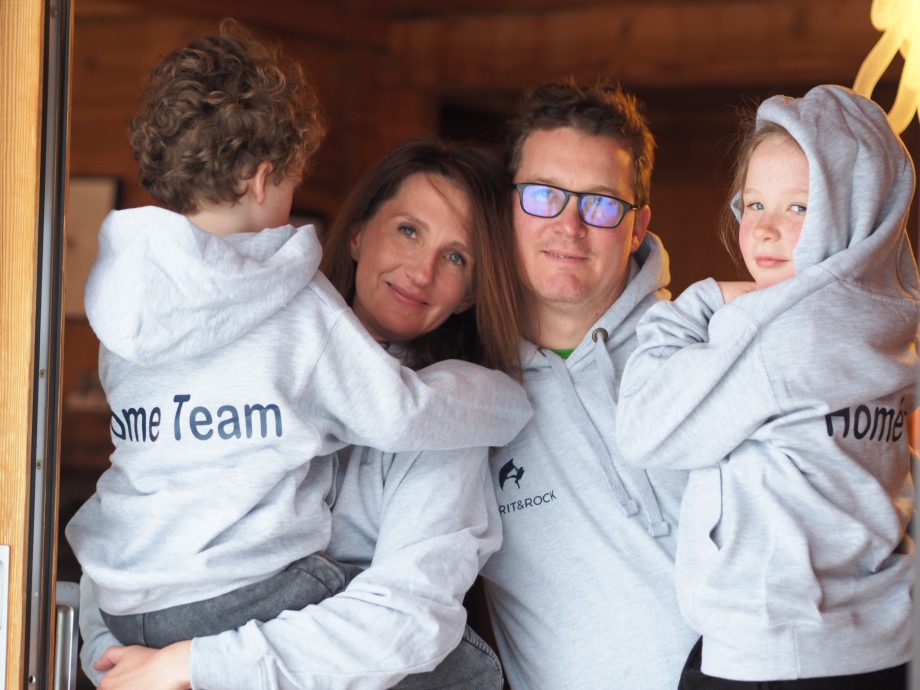
I had a professional life before I got into full-time mountaineering, which was assessing risk as an investor. And for me, understanding risk is about trying to break down the danger aspects into smaller bits.
I’ve been attacked on social channels with comments like,
What is this mother doing going up on Everest and leaving two children at home?
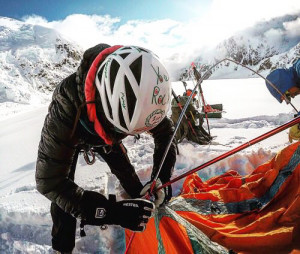 And I just think it’s a bad remark from a couch. Before I went to do Everest, I broke down the risk of why people die on Everest; which comes to cold injuries, inability to cope with altitude, and poor judgment. I’ve addressed those in my earlier expeditions. I’ve dealt with cold in Denali, Antarctica, skiing the South and North Poles and I know my threshold. With altitude, I’ve pretty much spent the last two years at high altitude, consistently going on expeditions. Just yesterday, I went up Mont Blanc—a 5,000-meter peak in 24 hours. So, I know my body can cope.
And I just think it’s a bad remark from a couch. Before I went to do Everest, I broke down the risk of why people die on Everest; which comes to cold injuries, inability to cope with altitude, and poor judgment. I’ve addressed those in my earlier expeditions. I’ve dealt with cold in Denali, Antarctica, skiing the South and North Poles and I know my threshold. With altitude, I’ve pretty much spent the last two years at high altitude, consistently going on expeditions. Just yesterday, I went up Mont Blanc—a 5,000-meter peak in 24 hours. So, I know my body can cope.
Returning to the question about motherhood. It’s irresponsible to go well beyond your competence and not rely on expertise. That’s why, for example, I did the Cassin Ridge with people who were more experienced, who I trusted, and who were world-class climbers. I know what I can and cannot do. So there’s a difference there. Taking risks well beyond what you can do is irresponsible for anyone—be that if you’re a parent or a child.
Could you share one skill or insight your career in business has taught you about mountaineering, and vice versa?
Oh, there are so many.
One insight that stands out comes from the field of behavioral finance, which tries to understand why in a world that should be so rational and formulaic, we have things that happen like the financial crisis in 2008. It looks into why people and the markets behave the way they do; like when we are confronted with fear and risk, and how at that point, we no longer think rationally. We tap into the primary cortex of our brain and start exhibiting traits which are very dangerous indeed.
For example, with K2 tragedies: why would a climber look at another who decides to go up amid a bad weather window and decide that they should follow? This is a common thing you’ll see in expeditions, where,
climbers assume that just because one person is taking a risk that they should too. Sure enough, before long, a group of five are up there trapped in a bad storm.
This is groupthink, and the exact thing happens in financial markets—where everyone decides to follow one hedge fund manager’s decision who appears to be some hero, but in the end, that same manager might lose their position completely and cause everyone else to as well. The financial markets aren’t unlike the mountains.
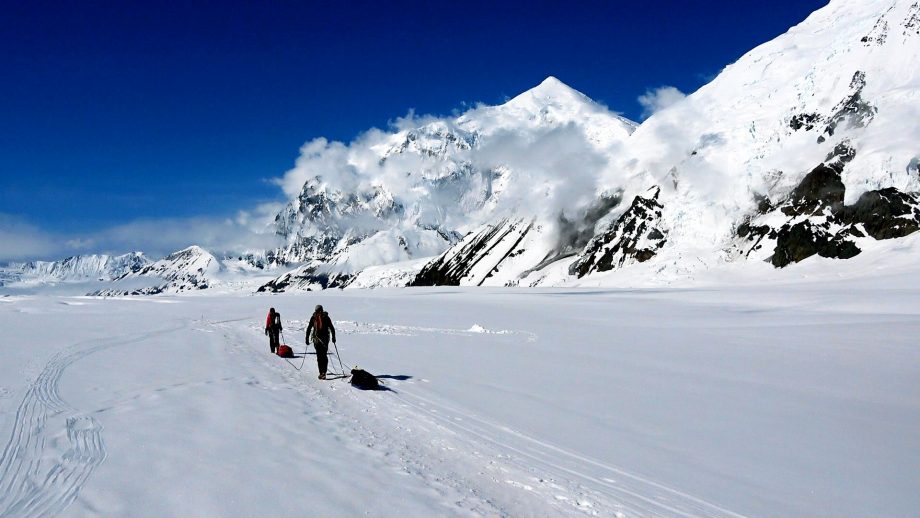
The other fallacy is overconfidence; when we think that because we have achieved acts—thanks to things like great weather and good luck—that we’re now fully capable of great things.
What I’ve learned in investing is to try to stay conservative. Don’t confuse luck for genius. The same can be said for climbing.
Conditions can change the difficulty of the route. I’ve done routes that should have taken eight hours, but instead they took 15. It’s not because I’m a bad climber, it’s because you’ll inevitably encounter a blizzard or have to come down through a crevasse field, where all of the sudden you can’t tell where the crevasse is and where the snow is. So clearly with bad weather conditions, you’ll lose time. That’s why you should never confuse luck or good conditions for genius or skill.
These behavioral ideas have certainly helped me in being aware—and I can’t say I can completely banish human indecision on the mountain—but it has made me aware of the bad decision-making that can happen.
So, onto the transferable stuff I’ve learned for business …
When I started rock climbing, I was amazed at how one small move can completely change your perception of what is doable and what is not doable. Like how an overhang can feel impossible to get over, but suddenly, you place your feet a little differently, and you can get over it.
In business, that’s tremendous. Instead of being stuck like a deer in headlights, you can push through and make small adjustments that can change your perspective on how terrible or how committing a situation really is.
When I started climbing, I had a 10-billion-dollar-plus portfolio of clients’ money around the hard financial times of 2008, and I was able to tell myself,
just make one small, incremental move. What small insight can I use to change the situation?
You began mountaineering later in life. What advice would you give to others who are in their 30s, 40s, or older who feel they might be too old to pick up climbing or another outdoor activity?
If you are in your 30s and go to the climbing gym and look at 15 or 16-year-old girls climbing, they’re clearly gonna kick your ass, right? Rock climbing—particularly indoors—is a lot like gymnastics, which can definitely feel disparaging against your age.
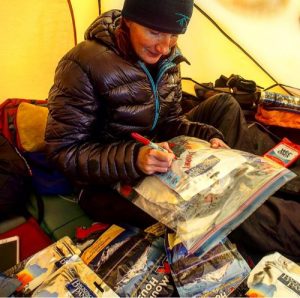 But mountaineering is actually a discipline that at least initially requires a pretty low level of basal fitness. That’s why I think it’s a beautiful sport for people who haven’t done much: you can start from a low level of fitness and extend your endurance to be able to do longer days and experience the beauty of adventure.
But mountaineering is actually a discipline that at least initially requires a pretty low level of basal fitness. That’s why I think it’s a beautiful sport for people who haven’t done much: you can start from a low level of fitness and extend your endurance to be able to do longer days and experience the beauty of adventure.
The way I got through the training for my adventure was by doing long routes in the Alps, which involve big days, sleeping under the stars and climbing at two in the morning on fresh snow. It really makes you fall in love with adventure. Especially the elation you feel just a few minutes before a summit. And you realize,
Wow, this is the joy of living. It was a bloody hard day, I’m exhausted, but I just love the feeling. This is a life worth living.
So my advice for people who want to get into mountaineering late in life is to do long days and do backcountry skiing to prep for high altitude. You have to accept that climbing outdoors or backcountry skiing is highly unpredictable, which means you need to be conditioned to cope with whatever weather or other obstacles arise. It doesn’t require anything outrageous physically; mostly, you need to train your mind to deal with long days and challenges.
What is one piece of advice you’d give to someone who is brand new to mountaineering? Likewise, what is one piece of advice you’d give to a veteran?
To the veterans I would say, expand your range. Emily Harrington, for example, who is an amazing rock climber, has extended herself into high altitude mountaineering. And she’d tell you that it gave her so many new experiences and feelings, and has probably extended her life as an athlete.
Again, in rock climbing, you can get easily intimidated by a 15-year-old with an incredible strength-to-weight ratio, but you can still climb in your 30s. So extend your range and expand your life outdoors, which can bring new objectives and new challenges.
Push yourself outside of your comfort zone. Just get to the starting line. You might think,
I can’t possibly do it.
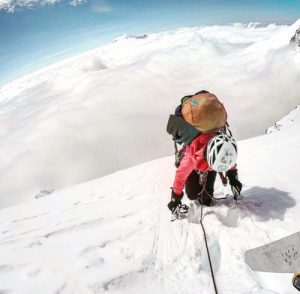 But you can. You have to be willing to put 10,000 hours in. You can do anything in life, just get to the starting line. And banish people in your life who discourage you.
But you can. You have to be willing to put 10,000 hours in. You can do anything in life, just get to the starting line. And banish people in your life who discourage you.
Surround yourself with people who can encourage your early wins and stretch you from the zone of optimism to the zone of accomplishment. It’s important to have the right attitude and the right skills.
Especially in mountaineering, saying, “I want to climb Everest in 2018” isn’t going to help you. What will help you is saying “I want to climb Everest in 2018 and to do that I will go to a basic mountaineering course, climb Mount Rainier with an IMGA guide to learn about crevasse rescue, working with crampons,” etc. That work will pay off. Just get to the starting line, surround yourself with the right people, and acquire the necessary skills.
When many climbers achieve a big objective, they might say that they’re done with that peak or route forever. Would you return to any of these seven summits?
Sure—and I have returned to some of them. Often, in mountaineering, it’s about doing another route on the same mountain. No mountain is the same when you climb it on a different route. The summit might be the same, but the journey is so different. So, I’d return to any of these mountains, and challenge myself with a different route. Every base and route are different, and that’s really the joy of it all.
Masha was supported by Sharpie Extreme and the messages by her children were written with Sharpie Extreme Permanent Markers because the high-contrast ink resists fading, even when faced with the most challenging conditions. Learn more about Sharpie Extreme and consider marking your gear with Sharpie Extreme permanent markers, as well.
To learn more about Masha Gordon and GRIT&ROCK –her charity aimed at empowering inner-city teenage girls to challenge themselves, increase self-confidence and pursue an active lifestyle—visit her website and following her Instagram, @gritandrock.
Additional contributions have been made to this article by: Natalie Siddique
Want more climbing content? Get our awesome climbing newsletter, delivered weekly.
Explore more
- Learning the Language of the Mountains
- To Keep Moving Forward: How Hard Things Can Make Us Heal
- Tetnuldi Camp 4 Journal—To Summit or Not to Summit?
- The Classic Alpinist—82 Summits with Ueli Steck
- 4 Steps for How to Transition to Alpinism
- Golden Limestone, Abandoned Quickdraws, and a Budweiser—How I Sent My First 5.12

